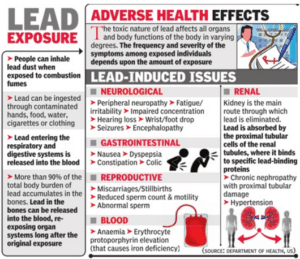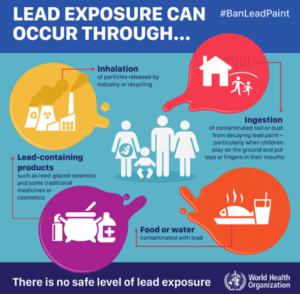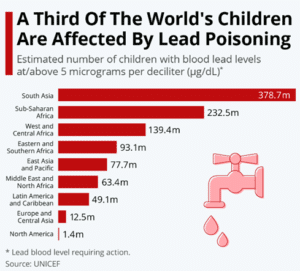A Hidden Adversary.
Relevance
- GS 2: Issues Relating to the Development and Management of Social Sector/Services relating to Health, Education, and Human Resources.
- Tags: #AarogyaBharat #LeadPoisoning #GS2 #IndianExpressEditorialAnalysis.
Why in the News?
Our nation’s future is threatened by lead poisoning as we strive to become “Aarogya Bharat” due to an invisible enemy.
Lead poisoning in India
- A study conducted in 2021 revealed a concerning issue related to lead exposure among children in India.
- Approximately more than half of the children, nearly 20 crore (200 million), were found to have lead levels in their blood surpassing 5 micrograms per decilitre (μg/dL).
Niti Aayog and CSIR Study (2022)
- Niti Aayog and CSIR did a follow-up study that confirmed the earlier findings.
- The study highlights the persistence of elevated blood lead levels among children in India.
The World Health Organization (WHO) defines a threshold as follows
- Any blood lead level above 5 g/dL is considered a critical point by the WHO, needing prompt intervention.
- Levels beyond this cutoff serve as an indicator for a thorough evaluation of the causes of lead exposure.
Impact of Low-Level Lead Exposure on Children
Epidemiological Findings
- Multiple epidemiological studies have conclusively demonstrated the harmful effects of even minimal lead exposure.
- These studies provide crucial evidence of the dangers posed by lead, especially for vulnerable populations like children.
- Children are especially vulnerable to lead exposure since their bodies and minds are still developing.
- They absorb lead at a higher rate due to their rapid growth, which increases the possibility of long-term harm.
Risk of Irreversible Damage
- Children that are exposed to lead might suffer permanent damage.
- Neurological impairments, hindering cognitive functions and learning abilities.
- Learning disabilities are a concerning outcome, affecting a child’s educational progress and future prospects.
- Organs like the kidneys, brain, and nervous system are at risk of damage, potentially leading to severe health issues.
Learning Gap and Economic Impact
- Recent analysis underscores that lead poisoning contributes to a substantial learning gap, especially between economically disparate countries.
- A significant portion of the educational disparity between rich and poor nations can be attributed to lead’s detrimental effects
Societal Burden and Economic Impact
- The toll on society is substantial as children with lead poisoning could struggle throughout their lives.
- Reduced educational attainment and economic productivity can hinder overall societal progress
Lead’s Historical Impact and Positive Changes
Historical Awareness and Actions
- Lead’s health risks have been known for a century.
- Early sources included gasoline, water-pipes, and paints.
- Global governments acted decisively to eliminate lead from these sources.
Positive Outcomes in Lead Removal
- Worldwide efforts led to lead-free gasoline, pipes, and paints.
- Notably in the US, gasoline lead reduction lowered blood lead by over 90% (1976-1995).
Lingering Concern in India
Lead poisoning is a recognized global concern, in India, lead exposure issues still persist.
- Many Indian buildings use lead-containing paints, over time, these deteriorate, releasing harmful dust.
- Old water pipes in India still contain lead.
- Lead exposure extends to food cans, ayurvedic medicines, and toys.
Occupational Hazards
- Certain jobs involve lead exposure, posing risks to workers, contaminated dust on clothing and bodies can unknowingly affect families.
- Occupations like lead mining, smelting, welding, soldering, and auto repair involve lead exposure.
- Occupational exposure extends beyond the workplace.
Unsound Battery Recycling
Alarming Battery Impact
- Used lead-acid batteries, common in vehicles, pose a significant concern.
- Unsound recycling practices contribute to exposure.
Weak Implementation of Regulations
- Despite strict rules, inadequate enforcement prevails.
- A substantial portion of used batteries enters the informal economy.
- Unregulated recycling in the informal sector contaminates neighborhoods.
- Environmental and health risks escalate due to improper practices.
Effective Interventions against Lead Exposure: A Glimmer of Hope
Despite challenges, interventions can effectively reduce lead exposure. Success stories offer hope for addressing lead-related issues.
Bangladesh’s Lead-Contaminated Turmeric Case
- Lead chromate pigment adulteration in turmeric was a major concern in Bangladesh.
- Multifaceted strategies were implemented (2017-2021).
- Elements included stringent regulations, swift detection, and consumer education.
Tangible Results
- Pre-intervention (2019), 47% of turmeric samples contained detectable lead.
- Post-intervention (2021), lead presence dropped to zero percent in market samples.
- Median blood lead levels reduced by 30% in the affected population within 16 months post-intervention.
Comprehensive Approach to Combat Lead Poisoning
Robust Legislative Framework
- Clear policies – defining health and safety standards, Guidelines for lead-acid battery, e-waste, and consumer product manufacturing and recycling.
- Enforcement of Standards – Stringent implementation of legally binding norms on safe paints and water pipes.
- Combating Informal Recycling – Strong laws against unregulated recycling. Restraining lead-containing waste’s improper use.
- Child Labor Prevention – Strict prohibition of child labor in e-waste and mining. Safeguarding young lives from hazardous work.
- Toxic Site Restriction – Controlled access to hazardous sites. Protecting communities from lead contamination.
Strengthened Monitoring and Reporting
- Monitoring System – Establish a robust monitoring and reporting mechanism. Include blood lead level testing and household surveys.
- Blood Lead Level Testing – Build capacity for blood lead level testing. Incorporate testing into health assessments.
- Contaminated Site Identification – Launch nationwide efforts to identify lead-contaminated sites.
Multi-faceted Regulatory Approach
- Reform and Enforcement – Implement regulatory changes for comprehensive lead exposure reduction. Ensure stringent enforcement of regulations.
- Contaminated Site Cleanup – Prioritize cleanup of contaminated areas, especially near residential and school zones. Mitigate risks to vulnerable populations.
- Sustainable Waste Management – Establish practices for proper waste management, including electronic waste.
Effective Coordination and Collaboration
- Inter-ministerial Coordination – Coordinate efforts across ministries and departments. Streamline action plans for holistic lead poisoning prevention.
- Government-NGO-International Partnerships – Collaborate with governmental agencies, NGOs, and international partners. Leverage diverse expertise for effective solutions.
Effective Public Awareness
- Targeted Awareness Programs – Vital need for well-designed public awareness initiatives.
- Awareness Focus – Highlight lead exposure dangers and sources. Direct appeals to parents, caregivers, schools, youth groups, community leaders, and healthcare professionals.
- Wide Spectrum of Communication – Engage multiple stakeholders through tailored messaging. Empower diverse groups to take proactive steps.
- Educational Outreach – Address workers and industry owners in lead-related sectors. Battery and electronic waste recyclers need informed guidance
Collective Action for Lead Poisoning Prevention
With strong government leadership, funding, innovation, and collaborations, we can:
- Curb lead contamination in daily-use products.
- Eliminate unsafe lead recycling and smelting.
- Remediate contaminated sites and ensure drinking water safety.
Benefits of reduction in lead poisoning are substantial like, Enhanced health and productivity, Higher IQs and reduced violence, Brighter future for children. Children are our legacy, carrying hope for a better India. Let’s empower them with health, strength, and optimism.
Source: Indian Express.
Mains Question
Explore the socio-economic consequences of lead poisoning in India. Discuss how lead exposure impacts educational attainment, workforce productivity, and overall societal development?
Source: Indian Express






